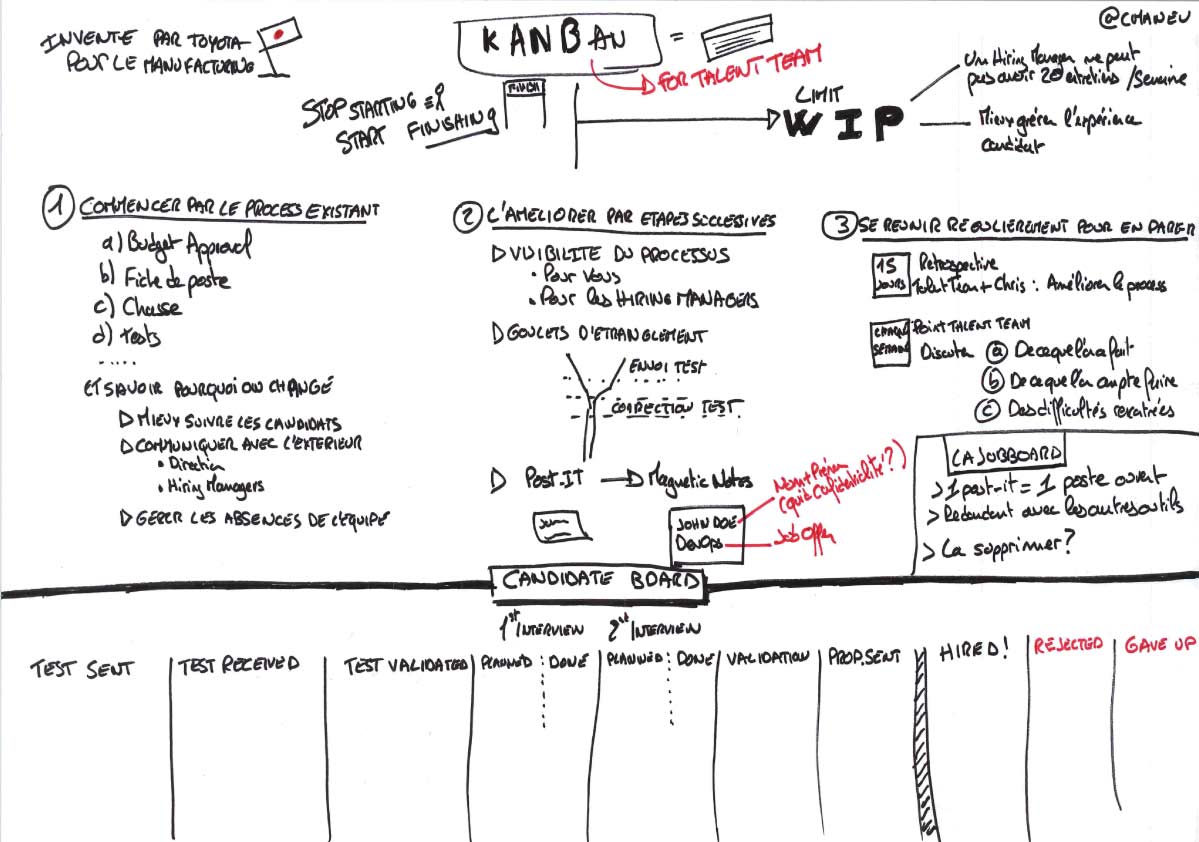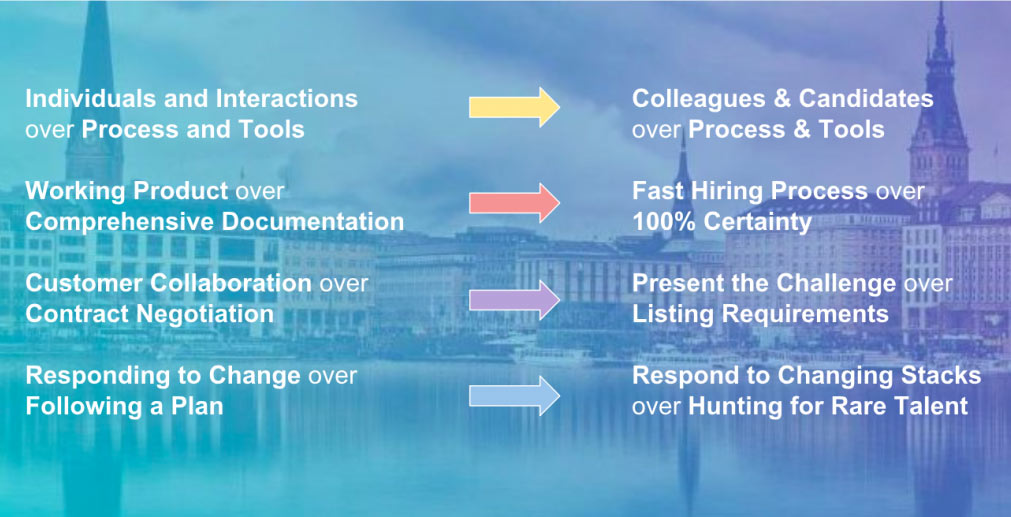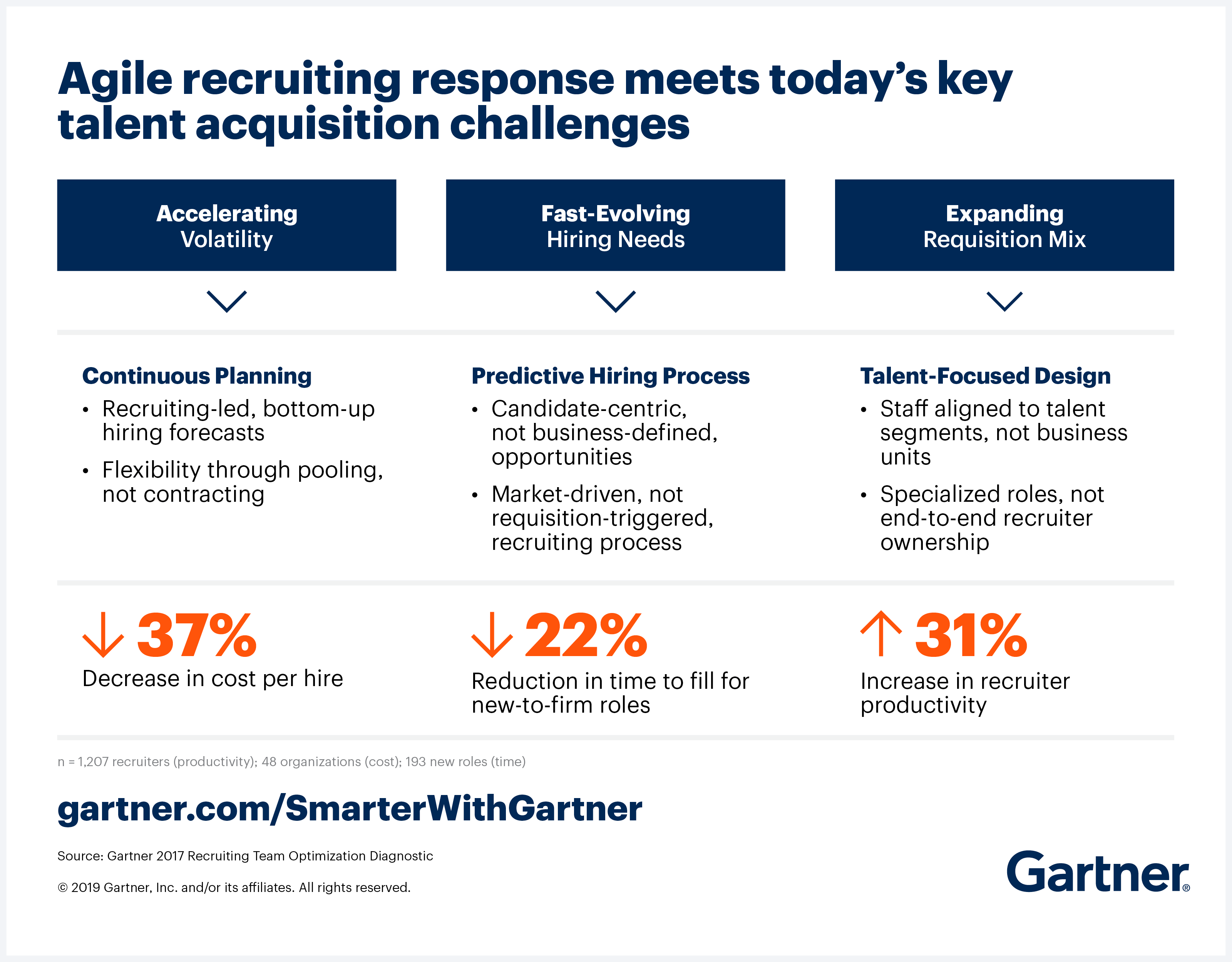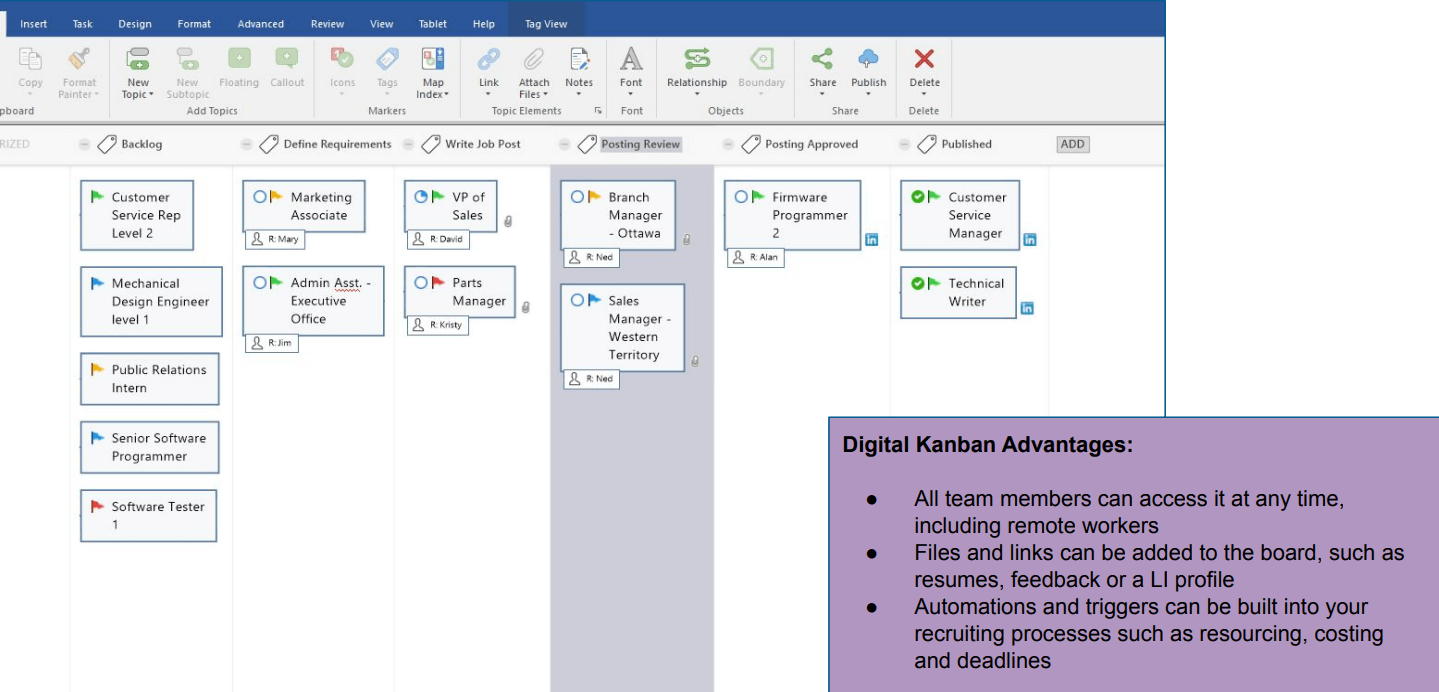Agile Recruiting: Top Tips and Best Practices For Recruiters
The COVID-19 pandemic has disrupted the way we work and may continue to do so in the next several months. We’ve discussed the bad and the ugly: Possible upcoming recession, increasing business costs, a health crisis.
Now it’s time to talk about the good. There is always a silver lining in the bleakest of times: Remote working may create a culture of empowerment and trust-based. A high-performance remote work culture is formed. And in turn, it creates opportunities for new organizational structures that will drive your company forward.
Flexibility is vital if you want to run your business like a winner. This is when Agile Recruiting comes in handy. For recruiting, agile recruiting lays a foundation for a better approach to prioritizing recruiting projects, better team collaboration, and a more effective talent acquisition process.
I. What is Agile Recruiting?
From The Buzzing Word In the Technology Industry
The idea of “agility” in business started with the Agile Manifesto, which was developed in 2001 for the technology development fields. This manifesto’s creators emphasized the philosophy of agility, which recruiters can understand as creating better, more collaborative, and more dynamic approaches to getting things done at high quality with continuous improvements.
The Agile Manifesto and principles received massive support from not only technology developers but also business leaders all around the world. Thus, after nearly 20 years, agile methodologies have been spreading across industries and adopted into many functions of businesses, including marketing, manufacturing, and human resources (Harvard Business Review)
From a broader perspective, agility in business or the agility of an organization can mean:
- Adapt quickly to market changes – internally and externally
- Respond rapidly and flexibly to customer demands
- Adapt to and lead changes in a productive and cost-effective way without compromising quality.
- Getting more referrals.
- Continuously be at a competitive advantage.
Businesses leaders and professionals have paid great attention to adopting agility in organizations. Adopting agility principles and values is expected to enable enterprises and individuals to be more adaptive and creative in dealing with complexity and uncertainty in an ever-changing world.
In a survey by Deloitte, 79% of global executives rated agile performance management as a high organizational priority. In addition, many respondents said that more of their employees undertake the agile way of working (McKinsey’s survey).
To the next trend for modern recruiting professionals
In short, the agile principles are often associated with adaptive, collaborative, and innovative. Roles are evolving, and modern recruiters also need to make changes to their recruitment process to stay at a competitive edge.
Agile Recruiting: In the recruitment context, adopting agile methodology and principles can be explained as slicing your hiring project into smaller pieces or a set of smaller tasks while structuring your work and process with short cycles. These short cycles are called sprints or blocks.
So, instead of diving into the sea of a lengthy recruitment process, modern recruiters now have smaller tasks with more precise completion times. Short cycles also increase more opportunities for feedback, learning, and correction along the process. This approach encourages collaboration between stakeholders while increasing flexibility and efficiency in the recruiting team and hiring managers’ visibility. Depending on each company’s situation, how the HR Department applies agile recruiting principles in their workplace may vary. Agile recruiting’s standard approach uses continuous planning, a predictive hiring process, and talent-focused design.
II. Benefits of Agile Recruitment
01. Speed up the recruitment process
When recruiters use the sprint methodology and structure their workflow around small tasks, they will have more control of the workflow and flexibility to shorten the recruitment procedures. Imagine that while in 36 days, a sprint cycle is only available for a duration from 2-...
As a result, star candidates can have timely results. The star candidates may not be available on the market for too long. If it takes them too much time to process to the next step, these talents may give up on your recruitment process and pick other companies instead.
As for recruiters who can not only reduce the average time-to-fill but successfully secure talented candidates, they will also experience positive feelings of task achievements.
In short, adaptive and speedy recruitment processes make everyone happy.
02. Instant Feedback
The idea of sprinting is to create more touchpoints between recruitment teams and other functions in the same period. Regular check-ins make it easier to engage with stakeholders in the process and receive real-time feedback to make proper adjustments.
For example, if something goes wrong or you are off target, you can examine and re-target your candidate search before wasting your time and your candidate’s time.
Short cycles and instant feedback also allow modern recruiters to implement the latest initiatives into their recruitment plans to get the job done faster and more effectively.
03. Enhance team performance and collaboration
Agile recruiting values colleagues and candidates over processes and tools. Recruiters are released from the fixed procedure and encouraged to design talent-focused hiring plans and optimize their workflow to achieve better results.
Companies can also form cross-functional teams to work on new, complex, or uncertain positions in a fast-evolving market. As a result, this process improves collaboration between related parties and encourages interdisciplinary problem-solving.
Better collaboration and a sense of empowerment can fuel the motivation of everyone on the team.
III. Setting up agile recruiting
The first note on setting up agile recruiting: This is not the only way to adopt agility into your recruitment activities. While agile recruiting’s standard approach uses continuous planning, a predictive hiring process, and talent-focused design, skill is more like a philosophy to adapt and customize.
As mentioned in previous parts, designing agile recruiting should allow adaptation and flexibility for better results in an evolving market. For the starting point, we suggest a 5-step approach for agile recruiting. However, Team leaders can customize these steps based on each company’s situation and available resources.
Step 01: Define the needs
The first step for HR professionals and business leaders is to review your resources, hiring strategy, and hiring plan.
These factors will affect the possibilities of adopting agile recruiting into your organization and how you can apply it. While GE introduced a new agile recruiting model, which will be analyzed below, Hewlett-Packard incorporated some agile principles into its recruiting process. Agile recruitment will be more helpful with complex positions. The requirements are not yet well understood, niche roles or roles that have never been recruited before, than the traditional ones.
The next part of this step is to organize short meetings with related stakeholders to define the jobs and clearly understand hiring managers’ expectations. It’s advisable to describe each job as a series of performance objectives and employee value proposition propositions rather than just experience and qualification.
Step 02: Assemble the right team
One common approach to applying agile recruitment into your daily workflow is to adopt Scrum, the most popular agile framework. As Scrum is based on the empirical process control theory, your new recruiting scrum team’s structure is pretty different from the typical recruitment team or HR function structure.
This Recruiting Scrum Team consists of three specific roles:
- Scrum Master: This person is responsible for promoting and supporting Scrum within the Recruitment Team and working on effective collaboration between the team and those outside. Scrum Masters monitor the scrum rules and help people understand the Scrum theory, values, and practices to maximize the scrum team’s results.
- Project Owner(or Product Owner in the Scrum guideline for developers): This person is responsible for maximizing the recruitment team’s effectiveness. The Project Owner works with Recruiting Scrum Team and other stakeholders to strategize the whole recruitment process’s vision and create a recruitment backlog. A recruitment Backlog is the ordered list of everything needed in the agile recruitment process.
- Recruitment Team: They are professionals who do the work to reach companies’ recruiting needs. They may consist of cross-functional officers with specialized skill sets to ensure that the whole team has all the skills needed to perform.
Because the Scrum framework’s nature is agile, adaptive, and interactive, smaller teams will perform better.
Step 03: Set a clear plan and Map the progress
After assembling your Recruiting Scrum Team, the next step is to start the Scrum process.
The process starts with listing the Recruitment Backlog, which was mentioned in the previous set, followed by a clear list of agile recruitment goals. The backlog is divided into different sprint cycles based on the company’s hiring plan. Then, as a sprint cycle lasts only from 2 to 4 weeks, the Recruiting Scrum Team should develop strategies for each sprint (sprint planning) to ensure that they can have the next few weeks working purposefully and effectively.
The next part of this step is to map or visualize the team’s process. This action ensures that people are on the same page, and the team’s performance is transparent and visible to the recruiting scrum team and other stakeholders. Visualizing the process also makes it easier to track individual performance and allows team members to see what they can adjust.
Recruiting Scrum Team can create its scrum board using the Kanban model in their office with a board/a wall, markers, and post-its. Writing items and tasks on Post-it notes is beneficial because Post-its can be tracked and moved quickly, and moving them from column to column is a positive signal of task progression. However, if your team works remotely, there are also a significant number of Kanban-style task organization tools available.
The Kanban board is a simple yet effective model to start building the recruiting team’s scrum board. But your team can make alterations after each sprint to create the most suitable one (check Deezer’s experiment of scrum boards below).
Step 04: Set up metrics and implement technology
The next step is to set up metrics to evaluate each sprint planning task. These metrics will help the recruiting scrum teams assess their performance, gauge the health and progress of their recruitment process, and make proper alternations or changes along the way if it is possible.
Maximizing the use of HR technology and tools is advisable to modern recruiters who adopt the agile methodology and Scrum framework. They can help HR professionals with standardization and automation, erasing administrative tasks’ burden and allowing space for adaptation and creativity. Recruiters should also keep their eyes on the latest recruitment trends and implement new initiatives if possible.
Step 05: Keep on sprinting, adapting, and repeat
As your team finishes the set-up steps, there are also several activities should be organized during each sprint: Daily Standup Meetings: A short daily meeting organized at the beginning of each day to ensure team alignment, give team members opportunities to update their progress, get feedback, and adapt quickly.
Sprint review and retrospective: These actions are held at the end of each sprint cycle. This is the time for the Recruiting Scrum Team to discuss the sprint cycle outcomes, what they have learned, and what they can prepare or improve in the next sprint. The Recruitment Backlog is also adjusted based on the change of business priorities during these meetings.
IV. Agile Recruitment Success Stories
01. GE – Reinvent in HR with Recruiting as a Service
With a long history of nearly 130 years, GE has continuously made bold moves to stay relevant in an ever-changing market. It started its reinventing journey in Human Resources with the introduction of RaaS, a new agile model for recruiting.
GE’s RaaS framework for agile recruitment was built based on the Scrum framework mentioned earlier with four key elements:
- The Recruiting Scrum Team: GE’s team is built as a cross-functional team focused on the execution and delivery of 2 to 5-week sprint cycles. They have all the needed skills to complete any backlog item.
- The Recruiting Scrum Master: A new role in the recruiting industry to facilitate scrum in the organization and shield the team from interruptions.
- The Headcount Owner: This person represents all hiring managers’ voices to organize the hiring backlogs and set priorities for each job order.
- Technology: A one-stop talent platform connecting talent pipelines, skills, technical assessments, and headcount backlogs. It also feeds a Kanban board to visualize the working process and enable progress visibility to all stakeholders.
This Agile Recruiting model allows GE to enable a fully immersive experience for the candidates.
Talented people don’t get lost and confused in the process, especially when not matched to a specific position. Plus, coordination between team members also got a lot better since information flows fluidly, and members can share information about candidates who may fit in more than one role.
By adapting to this agile model, GE continues to drive innovation and maintains its industry leader position.
02. Deezer – Applying agile recruitment with Kanban Board
Deezer‘s problem: Deezer did not harmonize its recruitment process between business units. As its team doubled after one year, many positions were opened, which resulted in too much back-and-forth communication and not good candidates’ experience.
Deezer’s Action: The recruitment and engineering teams teamed up to change the situation. Their application of Kanban for HR is part of a series of initiatives to enhance the collaboration between the HR/Recruitment team and engineering teams.

So what did Deezer’s HR team do:
- Step 01: Setting the goals: Deezer’s team goals were assembling the right team and addressing candidates’ pain points, including creating explicit processes, measurable metrics, and better reporting.
- Step 02: Preparation: They asked for support from the HR Director to implement new initiatives. They also mapped a clear picture of the current recruitment process, which they would analyze to make proper changes.
- Step 03: Applying Kanban board: At the first cycle, Deezer had 2 specific Kanban boards called the Job Board and Candidate board. The job-based board gave them an overview of all opened jobs, while the candidate-based board was to track candidates through the recruitment process.
- Step 04: Testing and improving after each iteration: After each iteration, they reflected on their setup, identified improving points, and moved to the next iteration.
Conclusion
Agile Recruiting methodology is not perfect and not an ex-Machina that works in every recruiting situation.
Recruiters also need to understand that agile recruitment is not about taking shortcuts, despite how it can be done by the book. Agile recruitment is not an excuse to skip building quality relationships with candidates.
On the contrary, it’s a way to approach the mission differently by splitting the overall big goals into approachable tickets and tackling them efficiently, with plenty of space for setbacks, iterations, collaboration, and improvements along the way. If you want to research more about Agile development, check out this informative article by TCGen.
Subscribe
All the recruiting news you see here, delivered straight to your inbox.
Just enter your e-mail address below
RecruitingBlogs on Twitter
Groups
-
Recruiters On LinkedIn
1801 members
-
Corporate Recruiters
316 members
-
Recruiting tips for begi…
180 members
-
The Recruiting Bar
190 members
-
Recruiting Humor
222 members
-
News from the Recruiting…
34 members
-
Contractors Recruitment
62 members
-
Recruitment Process Outs…
194 members
-
Virtual Recruiters Netwo…
619 members
-
Independent Recruiters
530 members
© 2025 All Rights Reserved
Powered by
![]()
Badges | Report an Issue | Privacy Policy | Terms of Service
About
With over 100K strong in our network, RecruitingBlogs.com is part of the RecruitingDaily.com, LLC family of Recruiting and HR communities.
Our goal is to provide information that is meaningful. Without compromise, our community comes first.
Join the Network!
RecruitingDaily.com
One Reservoir Corporate Drive
4 Research Drive – Suite 402
Shelton, CT 06484
Email us: info@recruitingdaily.com




You need to be a member of RecruitingBlogs to add comments!
Join RecruitingBlogs